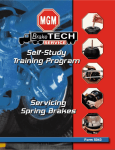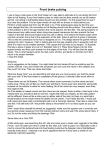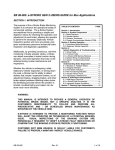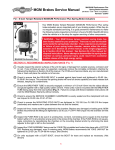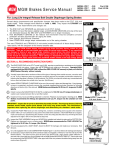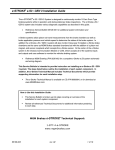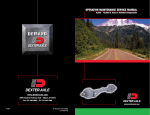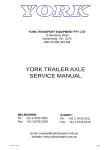Download Untitled - MGM Brakes
Transcript
FAST BRAKE trouble-shooting guide INDEX INTRODUCTION3 PRECAUTIONS3 INSPECTION4 Q&A • “Why does my spring brake have square air-inlet ports?” 4 • “Why is the yoke welded to the service push-rod?” 6 • “What do I do for a replacement?” 6 • “What happens if I replace a long stroke chamber with a different stroke unit?” 7 • “What’s the readjustment limit for 3-inch long stroke chambers? 8 • “Is the service side diaphragm different for a 3-inch long stroke brake?” 8 • “The service brake is not applying adequate force.” 8 • “The parking brake is not holding. There is insufficient parking force.” 11 • “The parking brake will not stay released (dragging brakes).” 12 • “Service brakes apply or the service exhaust valve leaks when air is applied to the parking brake.” 15 • “What is reverse cam rotation?” 15 PUBLICATIONS NOTES 18 19 2 MGM BRAKES WANTS TO HELP YOU KEEP YOUR TRUCKS AND TRAILERS ON THE ROAD. At MGM Brakes we know how important it is to keep your trucks on the road, and out of the garage, so the whole idea behind this booklet is to answer questions you might have and help you get to the bottom of brake problems fast. But first, here are a few common-sense precautions to take before you start. PRECAUTIONS 1. Always turn-off the engine before you work under any vehicle. 2. Always chock the wheels. Depleting air system pressure may allow the vehicle to roll. Keep your hands away from actuator push rods and slack adjusters; they may apply as the system pressure drops. 3. Never connect or disconnect a hose or line that contains air pressure. It may whip as air escapes. Never remove a component or pipe plug unless you’re sure that all system pressure has been depleted. 4. Never exceed recommended air pressure, and always wear safety glasses while working with air pressure. Never look directly into air lines or fittings, and never direct them at anyone. 5. Never try to dismantle a component until you have read and understand the recommended procedures. Some units contain powerful springs and injury is possible if they are not properly dismantled. Use only the correct tools, and observe all precautions relative to the use of those tools. 3 INSPECTION Before you begin testing the air brake system, it’s important to perform the following checks: 1. Examine all tubing and/or hoses for signs of kinks or dents. 2. Check all tubing and/or hoses for signs of wear, drying out or damage due to excessive heat. 3. Check the suspension of all tubing and/or hoses. They should be supported and should not vibrate. Position them so they will not be subject to excessive heat or wear against another part. 4. Determine the brand name, model and/or part number of the spring brake. Q&A Now, you’re ready to start. Here’s a list of commonly asked questions and complaints (in red), along with possible causes and recommendations on how to correct them. “Why does my spring brake have square air-inlet ports?” Trucks, tractors and trailers are being manufactured with both standard 2.5-inch stroke and 3-inch long stroke spring brakes and service chambers, so it is important to know how to identify what is on your equipment. 1. All 3-inch “long stroke” chambers can be easily identified by their square air-inlet ports (A), trapezoidal I.D. tags (B) and servicing instructions embossed into the aluminum center case (C). 4 2. Long stroke service chambers are identified by a ½-inch high square raised embossment on top of the pressure cap (D), along with the trapezoidal I.D. tag (E) and embossed instructions on the pressure cap (F). 5 “Why is the yoke welded to the service push rod?” Many 3-inch “long stroke” spring brakes and service chambers are equipped with “welded” yokes (G), which are permanently attached to the service push rod, making removal and reuse virtually impossible. “What do I do for a replacement?” Unless the non-pressure housing (mounting base) (H), push rod (I), and/or the yoke (J) have been damaged, or are severely worn, replacement of the single/piggyback unit only is recommended. (Refer to MGM Product Bulletin 03-003) If replacement of the combination/tandem unit is required, it should be replaced with a “welded yoke” replacement unit only. (Refer to MGM Product Bulletin 03-003) Do not attempt to replace a “welded yoke” actuator with a universal “cut to fit” aftermarket all-threaded rod 6 replacement unit. While it may be possible to cut the rod at, or near, the correct length, the combination of the threaded yoke and jam nut (K) may prevent the unit from achieving zero-stroke, or, if the push rod opening in the NPC is large enough, the jam nut will protrude into the NPC and may damage the protective stone shield. (Refer to MGM Technical Bulletin 03-002) “What happens if I replace a long stroke chamber with a different stroke unit?” Due to the difference in operational characteristics of 2.5-inch and 3-inch stroke chambers, mixing strokes across an axle may cause an imbalance in the braking capability of the vehicle. This may result in the vehicle being “pulled” toward the side with the “long stroke” unit during “emergency” stopping situations. (See MGM Technical Bulletin 02-002) IMPORTANT NOTE: – When servicing a truck/trailer equipped with 3-inch long stroke actuators, it is crucial that you replace “like for like” and do not install a standard 2.5-inch stroke actuator in place of the “long stroke” unit. (Refer to MGM Product Bulletin 02-002) 7 “What’s the readjustment limit for 3-inch long stroke chambers?” The readjustment limit has been set at 2.50-inches for 3-inch long stroke actuators. “Is the service side diaphragm different for a 3-inch long stroke brake?” Yes. When replacing the service diaphragm of a 3-inch “long stroke” chamber, you MUST replace with a 3-inch “long stroke” diaphragm. Installation of an incorrect diaphragm will change the performance characteristics of the actuator, adversely affecting its operating efficiency, and may result in a catastrophic failure. “The service brake is not applying adequate force.” 1. Improper brake adjustment. With brakes applied, check the brake chamber piston rod to see if the orange MGM Stroke Alert stripe is showing (L). If so, readjust the slack adjuster in accordance with its manufacturer’s instructions. Be certain that the spring parking brake chamber is fully released during this adjustment. NOTE: Automatic slack adjusters (ASAs) should not need to be manually adjusted in service. ASAs should not have to be adjusted to correct excessive push rod stroke. The excessive stroke may be an indication that a problem exists with the foundation brake, ASA, brake actuator or other system components. Troubleshoot the problem, replacing suspect components and then confirming proper brake operation prior to returning the vehicle into service. In the event that a manual adjustment must be made (although not a common practice), a service appointment and full foundation 8 brake, ASA, and other system component inspection should be conducted as soon as possible to ensure integrity of the overall brake system. 2. Available air pressure to brake chamber insufficient (M). Is the system air pressure gage reading normal? If it’s reading low, check compressor for proper operation. Look for kinked or blocked air lines. Check for defective valves. 3. Excessive brake lining or drum wear. Handle in accordance with the manufacturer’s inspection instructions. Check for incompatibility of truck and trailer brake chambers. Check brake chambers to insure they are fully released when brakes are not applied. 4. Improper slack adjuster operation or set-up. The angle made by the brake actuator push rod with respect to the mounting surface should be perpendicular within +3° from zero to full stroke. The rod clearance hole (N) in the non-pressure chamber (mounting base) for the brake actuator push rod should not be elongated or show evidence of rubbing from the rod. 9 With brakes applied, using 80/90 P.S.I., the angle (O) between the push rod and slack adjuster should never be less than 90°. Consult the slack adjuster manufacturer’s literature for proper operation and set-up. 5. Damage to mounting bracket or non-pressure chamber. Check bracket and non-pressure chamber for cracks or other signs of damage. Verify that mounting nut torque is as specified in the MGM Service Manual. If structural damage is found, replace the defective parts immediately. Be sure to follow MGM Service Manual instruction for proper removal and reinstallation. 6. Improper sizing of brake chambers or excessive payload weight. Consult with vehicle manufacturer, documentation or representative. 7. Brake chamber or air system (lines, fittings, valves) leakage. There may be a system leak if the compressor comes on often, or pressure is unable to be maintained. Examine all lines, fittings and valves for proper connection and leakage. If no problems are found, inspect brake chambers for leakage. Listen for an 10 audible sound, or spray the clamp bands with a soap/ water solution. If leakage is found at the service side clamp area, check the torque on clamp band ears and verify it is adequate per the MGM Service Manual. If the leakage persists, replace the diaphragm and clamp bands per instructions in the MGM Service Manual. CAUTION: If leakage is found at.... a. b. c. spring side clamp area, end plug, first valve in air line ahead of the spring brake (emergency release), ....replace the valve if required OR the entire piggyback per instructions in the appropriate MGM Brakes Service Manual. Be sure to install the release bolt and cage the spring per MGM Brakes Service Manual prior to removal. Never attempt to open or disassemble any spring brake single/piggyback chamber. 8. Improper push-rod length. This may be the problem if proper rod angularity is difficult to achieve, and/or frequent readjustment is necessary. Consult the vehicle manufacturer for proper rod length. “The parking brake is not holding. There is insufficient parking force.” 1. Refer to the possible causes just discussed under “Service brake not applying adequate force.” 11 2. Broken power spring. Remove the end plug from the release bolt access hole of the brake chamber (P). Use a flashlight to check for evidence of spring breakage. Brake chamber stroke (Q) can also be checked while applying and releasing the parking brake. If the expected range of motion is not observed, the spring may be broken. Also, the contents will rattle if the piggyback is removed and shaken, indicating a probable broken spring. Replace with appropriate MGM piggyback. “The parking brake will not stay released” (Dragging brakes) 1. Available air pressure to the brake chamber insufficient. Is the system air pressure gauge reading normal? If it’s low, check the compressor for proper operation. Look for kinked or blocked air lines. Check for defective valves. 2. Service application air is not exhausting properly. Apply and release service brakes while listening to exhaust. If the sound is not normal, check for kinked or blocked air lines or defective valves. 12 3. The spring brake piston (R) is binding before the piston is fully retracted. Release the parking brake. (Remove the end plug (P) and apply 90-100 P.S.I. air pressure.) Look into the end plug hole to see if the top of the piston is approximately .200 inches from the head. If not, replace the single/ piggyback with a MGM piggyback or piggyback plus kit. 4. Broken return spring in the service chamber (T). Remove piggyback and service diaphragm (U) and inspect the return spring (T). If broken, replace with a new return spring and new diaphragm. Order only genuine MGM brand replacement parts and install in accordance with the appropriate MGM Brakes Service Manual instructions. 5. Ruptured diaphragm (V) or damaged push-rod seal (W). Check for leakage at the parking chamber vent holes or through the release bolt hole. Remove the release bolt access hole end cap (X) and apply air to spring brakes (release). If you feel or hear air escaping in these areas, the diaphragm is defective. 13 REPLACE ENTIRE PIGGYBACK AS INSTRUCTED IN THE MGM SERVICE MANUAL. If air applied to the spring chamber has a tendency to apply the service brake, or to cause the service exhaust valve to leak, the push rod seal is leaking (W). (To verify, remove the service air line and apply air to the parking chamber. If air is detected coming through the open service air port, the push-rod seal is leaking.) Replace the entire piggyback as instructed in the appropriate MGM Brakes Service Manual. 6. Autoslack over-adjustment or camshaft linkage binding. Consult the manufacturer’s service manual. 7. Broken power spring (Y) or return spring (Z) in parking brake section. A broken power spring can be diagnosed as discussed in the previous section. A broken return spring in the parking chamber is difficult to diagnose. Either case requires the complete replacement of the piggyback. 14 “Service brakes apply or the service exhaust valve leaks when air is applied to the parking brake.” 1. Air is leaking through the push-rod seal (W). Replace the entire piggyback as instructed in the MGM Service Manual. “Why do my brakes exhibit some, or all, of the following symptoms?” • • • • • • Excessive Noise When Braking Loose or Broken Brake Spider Bolts Parking Brake Center Seal Leaks Loose or Broken Chamber Mounting Bolts Brakes That Grab Broken Piggyback Center Push Rod Plate Screw These “symptoms” are usually associated with “reverse” cam rotation, or s-cam rotation opposite of the forward rotation of the wheel. The “vibration” generated by this foundation brake arrangement is most noticeable in the leading shoe, which, due to the rotation of the wheel away from the drum, forces the cam to rotate backwards, resulting in a “chattering” sound. This rapid back and forth movement of the cam is amplified when the “natural” frequency (vibration) of the complete system: i.e. foundation brake, push rod, brake actuator and suspension; is at, or near, its resonate frequency. If the linings, camshaft bushings and other component parts are worn, replacement may temporally correct, or quiet, the problem. 15 Cam Rotation Opposite Wheel Forward Wheel Rotation Vertical Travel Direction Camshaft Rotation FINALLY As the industry leader, MGM Brakes backs its products with strong warranties—and an equally strong commitment to the people and companies who buy them. While the Fast Brake Trouble-Shooting Guide is a result of that dedication, our commitment doesn’t end here. The air-brake system is a complex web of valves, tubing and other components and, try as we might, it’s impossible to cover every trouble-shooting eventuality. If you need advice on problems that go beyond what we have presented here, feel free to call your MGM Brakes Sales Representative, or contact our Customer Service Department at: 1-800-527-1534 16 Or go on line to www.MGMBrakes.com to reference technical bulletins, product brochures and general catalog information. Also, keep in mind that most heavy-duty truck/trailer parts dealers and fleet specialists can provide MGM Brakes product information and genuine OEM service replacement assemblies for all other makes of spring brakes. At MGM Brakes, our commitment doesn’t stop when you buy our products. The way we see it, it’s just beginning. 17 PUBLICATIONS The following publications have been referenced in this guide. All can be downloaded from the MGM Brakes web site where ‘hard copies’ can also be requested. Please visit our web site or contact your local/regional MGM Brakes representative for more information. • MGM Brakes Product Bulletin (03-003) Replacement Units for MGM Brakes 3-Inch Long Stroke Chambers with Welded Yokes • MGM Brakes Technical Bulletin (03-002) Field Replacement of MGM Brakes Chambers Equipped with Welded Yokes • MGM Brakes Technical Bulletin (02-002) Mixing Standard & Long Stroke Chambers • MGM Brakes Model TR-Series Service Manual (Form No. 5011) • MGM Brakes Model LTR-Series Service Manual (Form No. 5042) • MGM Brakes Model MAGNUM Performance Plus (MJ-Series) Service Manual (Form No. 5044) • MGM Brakes BrakeTECH Service Self-Study Training Program (Form No. 5043) 18 NOTES 19





















